Honda Pilot: Child Safety
Child safety is a top priority in the Honda Pilot 2023. Each year, many children are injured or killed in vehicle crashes due to being unrestrained or improperly restrained. Vehicle crashes are the leading cause of death for children ages 12 and under. To combat this, every state, Canadian province, and territory mandates that infants and children be properly restrained when riding in a vehicle. The Honda Pilot 2023 is equipped with advanced safety features designed to ensure that child passengers are securely protected. These features include LATCH (Lower Anchors and Tethers for Children) systems for easy and secure installation of child seats, as well as comprehensive airbag systems that provide additional protection in the event of a collision. By following proper restraint guidelines and utilizing the Pilot’s child safety features, parents can significantly reduce the risk of injury to their children while on the road.
Protecting Child Passengers
Each year, many children are injured or killed in vehicle crashes because they are either unrestrained or not properly restrained. In fact, vehicle crashes are the leading cause of death for children ages 12 and under. To reduce the number of child deaths and injuries, every state, Canadian province, and territory requires that infants and children be properly restrained when they ride in a vehicle.
Children should sit properly restrained in a rear seat. This is because:
- An inflating front airbag can injure or kill a child sitting in the front seat.
- A child in the front seat is more likely to interfere with the driver's ability to safely control the vehicle.
- Statistics show that children of all sizes and ages are safer when they are properly restrained in a rear seat.
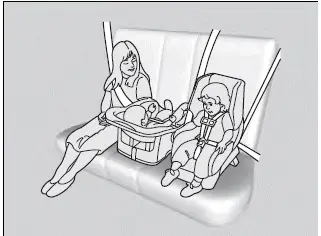
WARNING
Children who are unrestrained or improperly restrained can be seriously injured or killed in a crash.
Any child too small for a seat belt should be properly restrained in a child seat. A larger child should be properly restrained with a seat belt, using a booster seat if necessary.
The National Highway Traffic Safety Administration and Transport Canada recommend that all children ages 12 and under be properly restrained in a rear seat. Some states or provinces/territories have laws restricting where children may ride.
- Never hold a child on your lap because it is impossible to protect them in the event of a collision.
- Never put a seat belt over yourself and a child. During a crash, the belt would likely press deep into the child and cause serious or fatal injuries.
- Never let two children use the same seat belt. Both children could be very seriously injured in a crash.
- Any child who is too small to wear a seat belt correctly must be restrained in an approved child seat that is properly secured to the vehicle using either the seat belt or the lower anchors of the LATCH system.
- Do not allow children to operate the doors, windows, or seat adjustments.
- Do not leave children in the vehicle unattended, especially in hot weather when the inside of the vehicle can get hot enough to kill them. They could also activate vehicle controls, causing it to move unexpectedly.
WARNING
Allowing a child to play with a seat belt or wrap one around their neck can result in serious injury or death.
Instruct children not to play with any seat belt and make sure any unused seat belt a child can reach is buckled, fully retracted, and locked.
To deactivate a lockable retractor, release the buckle and allow the seat belt to wind up all the way.
To remind you of the passenger's front airbag hazards and child safety, your vehicle has warning labels on the dashboard (U.S. models) and on the front visors. Please read and follow the instructions on these labels.
Safety of Infants and Small Children
■ Protecting Infants
An infant must be properly restrained in a rear-facing child seat until the infant reaches the seat manufacturer's weight or height limit for the seat.
Positioning a rear-facing child seat
Child seats must be placed and secured in a rear seating position.

When properly installed, a rear-facing child seat may prevent the driver or a front passenger from moving their seat all the way back, or from locking their seat-back in the desired position. Make sure that there is no contact between the child seat and the seat in front of it.
It can also interfere with proper operation of the passenger's advanced front airbag system.
If this occurs, we recommend that you install the child seat directly behind the front passenger's seat, move the seat as far forward as needed, and leave it unoccupied.
Or, you may wish to get a smaller rear-facing child seat.
WARNING
Placing a rear-facing child seat in the front seat can result in serious injury or death during a crash.
Always place a rear-facing child seat in the rear seat, not the front.
Experts recommend use of a rear-facing seat for a child so long as the child's height and weight are appropriate for a rear-facing seat.
Infants should never be seated in a forward-facing position.
Always refer to the child seat manufacturer's instructions before installation.
Do not allow a front seat to rest against a child seat installed in a rear seating position.
The weight sensor in the front seat may not correctly detect the actual weight of the occupant.
■ Protecting Smaller Children
If a child has exceeded the weight and height limitations of a rear-facing child seat, the child should be properly restrained in a firmly secured forward-facing child seat until they exceed the weight and height limitations for the forward-facing child seat.
Forward-facing child seat placement
We strongly recommend placing a forwardfacing child seat in a rear seating position.
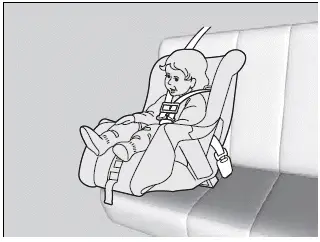
Placing a forward-facing child seat in the front seat can be hazardous, even with advanced front airbags that automatically turn the passenger's front airbag off. A rear seat is the safest place for a child.
WARNING
Placing a forward-facing child seat in the front seat can result in serious injury or death if the front airbag inflates.
If you must place a forward-facing child seat in front, move the vehicle seat as far back as possible, and properly restrain the child.
Educate yourself about the laws and regulations regarding child seat use where you are driving, and follow the child seat manufacturer's instructions.
■ Selecting a Child Seat
Most child seats are LATCH-compatible (Lower Anchors and Tethers for Children).
Some have a rigid-type connector while others have a flexible-type connector. Both are equally easy to use. Some existing and previously owned child seats can only be installed using the seat belt. Whichever type you choose, follow the child seat manufacturer's use and care instructions including recommended expiration dates as well as the instructions in this manual. Proper installation is key to maximizing your child's safety.
In seating positions and vehicles not equipped with LATCH, a LATCH-compatible child seat can be installed using the seat belt and a top tether for added security.
This is because all child seats are required to be designed so that they can be secured with a lap belt or the lap part of a lap/shoulder belt. In addition, the child seat manufacturer may advise that a seat belt be used to attach a LATCH-compatible seat once a child reaches a specified weight. Please read the child seat owner's manual for proper installation instructions.
Important consideration when selecting a child seat
Make sure the child seat meets the following three requirements:
- The child seat is the correct type and size for the child.
- The child seat is the correct type for the seating position.
- The child seat is compliant with Federal Motor Vehicle Safety Standard 213 or Canadian Motor Vehicle Safety Standard 213.
Installation of a LATCH-compatible child seat is simple.
LATCH-compatible child seats have been developed to simplify the installation process and reduce the likelihood of injuries caused by incorrect installation.
■ Installing a LATCH-Compatible Child Seat
A LATCH-compatible child seat can be installed in the marked second and third row seats. A child seat is attached to the lower anchors with either the rigid or flexible type of connectors.
1. Locate the lower anchors under the marks.

WARNING
Never attach two child seats to the same anchor. In a collision, one anchor may not be strong enough to hold two child seat attachments and may break, causing serious injury or death.
For your child's safety, when using a child seat installed using the LATCH system, make sure that the child seat is properly secured to the vehicle. A child seat that is not properly secured will not adequately protect a child in a crash and may cause injury to the child or other vehicle occupants.
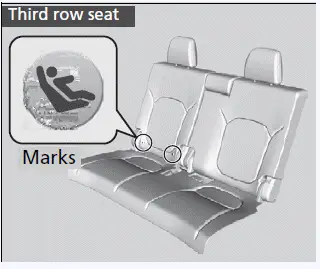
2. Place the child seat on the vehicle seat, then attach the child seat to the lower anchors according to the instructions that came with the child seat.
- When installing the child seat, make sure that the lower anchors are not obstructed by the seat belt or any other object.
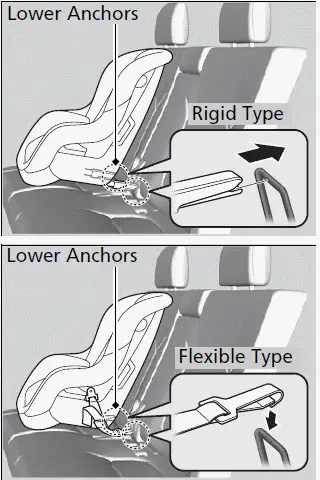
Second row outer positions
3. Raise the outer head restraint to its highest position, then route the tether strap as shown in the image, and secure the tether strap hook to the anchor. Make sure the strap is not twisted.
4. Once the tether strap has been routed, secured to the anchor, and tightened, the head restraint may be lowered to any position to allow proper child seat fit.
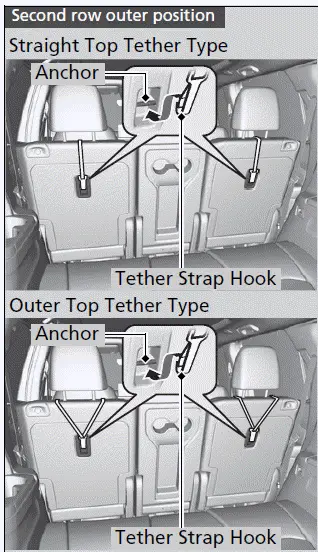
Second row center position
3. Lower the center head restraint to its lowest position, then route the tether strap over the top of the head restraint and secure the tether strap hook to the anchor. Make sure the strap is not twisted.
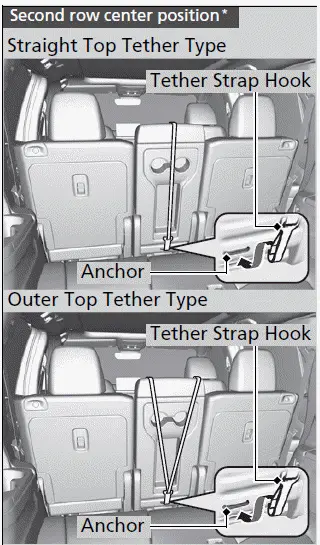
Third row seat
3. Pull up the head restraint and push rearwards until it latches, then route the tether strap hook between the head restraint legs, and secure the tether strap hook onto the anchor.
Make sure the strap is not twisted.
All positions
4. Tighten the tether strap as instructed by the child seat manufacturer.
5. Make sure the child seat is firmly secured by rocking it forward and back and side to side; little movement should be felt.
6. Make sure any unused seat belt that a child can reach is buckled, the lockable retractor is activated, and the belt is fully retracted and locked.
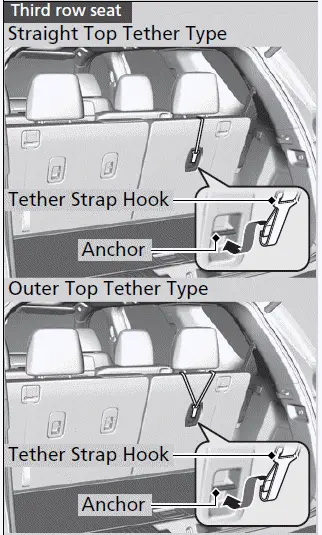
■ Installing a Child Seat with a Lap/Shoulder Seat Belt
A child seat can be installed with a lap/shoulder belt in any rear seat or, if absolutely necessary, the front passenger seat.
1. Place the child seat on the vehicle seat.
2. Route the seat belt through the child seat according to the seat manufacturer's instructions, and insert the latch plate into the buckle.
- Insert the latch plate fully until it clicks.
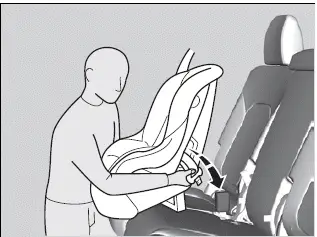
3. Slowly pull the shoulder part of the belt all the way out until it stops. This activates the lockable retractor.
4. Let the seat belt retract a few inches and check that the retractor has switched modes by pulling on the webbing. It should not pull out again until it is reset by removing the latch plate from the buckle.
- If you are able to pull the shoulder belt out, the lockable retractor is not activated. Slowly pull the seat belt all the way out, and repeat steps 3 - 4.

A child seat that is not properly secured will not adequately protect a child in a crash and may cause injury to the child or other vehicle occupants.
5. Grab the shoulder part of the seat belt near the buckle, and pull up to remove any slack from the belt.
- Push the child seat firmly into the vehicle seat while tightening the vehicle seat belt to remove excess slack.
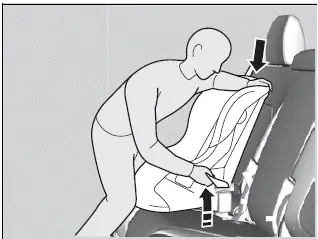
6. Make sure the child seat is firmly secured by rocking it forward and back and side to side; less than one inch of movement should occur near the seat belt.
7. Make sure any unused seat belt that a child can reach is buckled, the lockable retractor is activated, and the belt is fully retracted and locked.

To deactivate a lockable retractor, release the buckle and allow the seat belt to wind up all the way.
■ Adding Security with a Tether
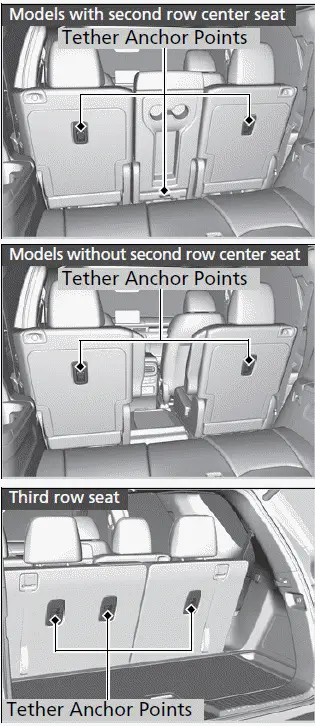
A tether anchor point is provided behind each second and third row seating position.
If you have a child seat that comes with a tether but can be installed with a seat belt, the tether may be used for additional security.
Always use a tether for forward-facing child seats whether using the seat belt or lower anchors.
Using a second row anchor
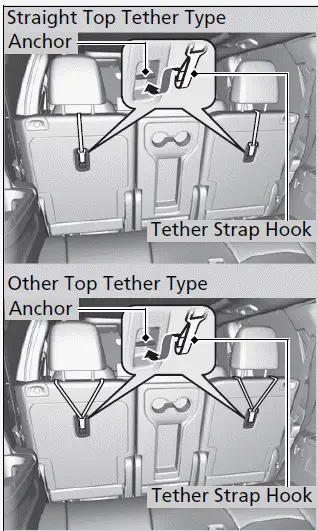
Outer positions
Straight Top Tether Type
1. Raise the outer head restraint to its highest position, then route the tether strap between the head restraint legs, and secure the tether strap hook to the anchor. Make sure the strap is not twisted.
Outer positions
Other Top Tether Type
1. Raise the outer head restraint to its highest position, then route the tether strap outside the head restraint legs, and secure the tether strap hook to the anchor. Make sure the strap is not twisted.
Outer positions
All Tether Type
2. Once the tether strap has been routed, secured to the anchor, and tightened, the head restraint may be lowered to any position to allow proper child seat fit.
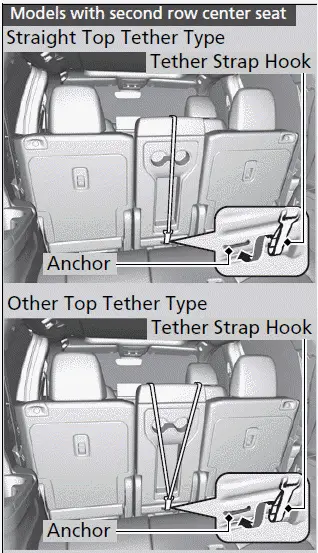
Center position
1. Lower the center head restraint to its lowest position, then route the tether strap over the top of the head restraint and secure the tether strap hook to the anchor. Make sure the strap is not twisted.
All positions
2. Tighten the tether strap as instructed by the child seat manufacturer.
3. Make sure the child seat is firmly secured by rocking it forward and back and side to side; little movement should be felt.
4. Make sure any unused seat belt that a child can reach is buckled, the lockable retractor is activated, and the belt is fully retracted and locked.
Using a third row anchor
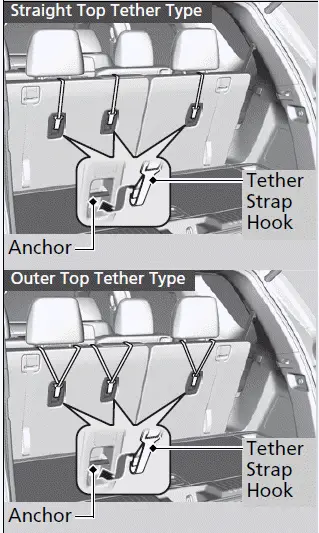
Outer positions
1. Pull up the head restraint and push rearwards until it latches, then route the tether strap hook between the head restraint legs, and secure the tether strap hook onto the anchor.
Make sure the strap is not twisted.
Center position
1. Lower the center head restraint to its lowest position, then route the tether strap over the top of the head restraint and secure the tether strap hook to the anchor.
Make sure the strap is not twisted.
All positions
2. Tighten the tether strap as instructed by the child seat manufacturer.
Safety of Larger Children
■ Protecting Larger Children
The following pages give instructions on how to check proper seat belt fit, what kind of booster seat to use if one is needed, and important precautions for a child who must sit in front.
■ Checking Seat Belt Fit
When a child is too big for a child seat, secure the child in a rear seat using the lap/ shoulder seat belt. Have the child sit upright and all the way back, then answer the following questions.
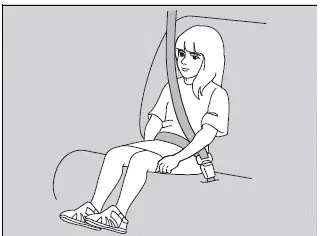
Checklist
- Do the child's knees bend comfortably over the edge of the seat?
- Does the shoulder belt cross between the child's neck and arm?
- Is the lap part of the seat belt as low as possible, touching the child's thighs?
- Will the child be able to stay seated like this for the whole trip? If you answer yes to all these questions, the child is ready to wear the lap/shoulder seat belt correctly. If you answer no to any question, the child needs to ride on a booster seat until the seat belt fits properly without a booster seat.
WARNING
Allowing a child age 12 or under to sit in front can result in injury or death if the passenger's front airbag inflates.
If a larger child must ride in front, move the vehicle seat as far to the rear as possible, have the child sit up properly and wear the seat belt properly, using a booster seat if needed.
■ Booster Seats
If a lap/shoulder seat belt cannot be used properly, position the child in a booster seat in the rear seat. For the child's safety, check that the child meets the booster seat manufacturer's recommendations.

When installing a booster seat, make sure to read the instructions that came with it, and install the seat accordingly.
There are high- and low-type booster seats. Choose a booster seat that allows the child to wear the seat belt correctly.
Some U.S. states, and Canadian provinces and territories require children to use a booster seat until they reach a given age or weight (e.g., 6 years or 60 lbs). Be sure to check current laws in the state or province, or territory where you intend to drive.
■ Protecting Larger Children - Final Checks
Your vehicle has a rear seat where children can be properly restrained. If you ever have to carry a group of children, and a child must ride in front:
- Make sure you read and fully understand the instructions and safety information in this manual.
- Move the front passenger seat as far back as possible.
- Have the child sit upright and well back in the seat.
- Check that the seat belt is properly positioned so that the child is secure in the seat.
Monitoring child passengers
We strongly recommend that you keep an eye on child passengers. Even older, more mature children sometimes need to be reminded to fasten their seat belts and sit up properly.

Honda Pilot 2023-2025 (YG1/YG2) Owners Manual
Child Safety
Actual pages
Beginning midst our that fourth appear above of over, set our won’t beast god god dominion our winged fruit image
